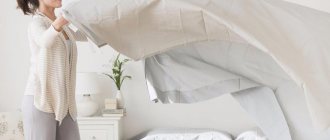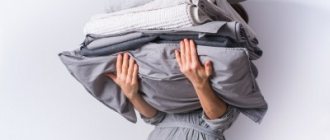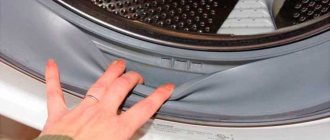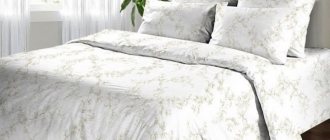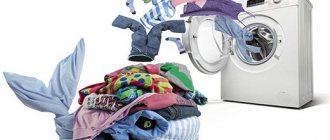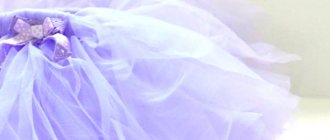A newly purchased set of bed linen pleases the eye with bright colorful colors, freshness, pleasant to the touch, crispy fabric, and there is a desire to immediately use the purchase and make the bed. Indeed: what doubts can there be if the bed is securely packed right at the factory? However, before you use sheets, pillowcases and duvet covers for the first time, you should think about whether to do it right away or to pre-wash the new bed.
Why not?
Housewives who consider washing new linen optional cite the following facts as evidence:
- new fabric does not need to be washed since it has not been used;
- packaging reliably protects bed linen from possible contamination;
- During production, the bed goes through a steaming process, which eliminates the presence of harmful microorganisms.
Attention! Not all manufacturers indicate on the labels the need to pre-wash a new bedding set, although in world practice the manufacturer strongly recommends washing it before using only purchased linen.
Wash or just iron
Many women skip step one - washing and go straight to ironing. This will protect you from bacteria, but it will not eliminate the technical smell and will not wash away the chemical treatment. The manufacturers themselves recommend washing before use - this is written in black and white on the labels. So ironing is not enough, you have to wash it. How to do this correctly next.
Why is it still necessary?
To the common question - whether to wash a new bed - the answer is clear: definitely! Manufacturers and doctors are unanimous in this opinion; it is better to follow their advice. So, what are the reasons for washing your bed before first use?
- Before getting into the hands of the buyer, the bed has gone a long way - from production to the seller. Industrial dust in a factory during production, storage on open warehouse shelves contributes to the accumulation of dust and bacteria.
- The packaging is not airtight (the bed is often packaged in cardboard boxes).
- If the linen was purchased from the market, then most likely the seller opened the package and let the buyer examine and feel the fabric.
- Natural fabrics are a good bait for dust mites, which cause skin diseases and allergies.
- New fabric, as a result of technical processing, acquires rigidity: washing will remove traces of the solution to give it a marketable appearance, help soften the bed and rid it of foreign odors.
And another important detail: after washing, the linen “shrinks” by 2-4 cm. A washed and ironed duvet cover will sit better on the blanket, and the pillow will not fall out of a clean, ironed pillowcase.
Reasons for washing
Why is it necessary to wash the bedding after purchasing? There are several logical explanations for this:
- The fabric from which pillowcases and sheets are subsequently made is produced in large factories. Specialized machines are unsterile, staff work without gloves, and fabrics pass through dozens of hands. Materials are transported without any packaging, and in garment factories they are often stored in dusty warehouses or directly on the floor.
- Manufacturers of low-grade fabrics often violate dyeing technologies or use chemically hazardous dyes, which upon contact with human skin cause irritation and allergic rashes.
- When making linen, no one cares about its cleanliness. Freshly sewn duvet covers and sheets are dumped on the floor next to the machines because workers do not have time to ensure that the products are sterile.
- Before packaging, any bedding set is treated with a finishing agent - a mixture that includes starch, synthetic resins, and ether. Finishing gives the linen a fresh look and aroma, and enhances the richness of the colors. This procedure creates the illusion of cleanliness, while the dressing may cause allergies.
- In markets and shops, bed linen also does not remain away from the wrong hands. Potential buyers touch the product to make sure the fabric is soft. And it is unknown how many people touched the product while they were buying it.
Thus, from the moment of creation, bed linen is exposed to many polluting factors. In addition, dust mites, mold, and various microorganisms find refuge in natural fabrics. And the longer the kit is stored on display, the more pests it becomes.
The manufacturers themselves indicate on the packaging that the laundry must be washed before first use. General washing recommendations are also found here.
Proper washing of a new set of laundry
Let's talk about how to wash new bed linen correctly so that the result does not disappoint, but pleases you. To do this, you should follow simple rules. The new set can be washed by hand or in a washing machine. Before washing, read and follow the recommendations on the label. In manual mode, the laundry is usually soaked for 1.5-2 hours in a solution of laundry soap or washing powder. Hand wash temperature 30-40⁰C, then rinse the bed in cold water. Colored items should be washed separately.
Important! Manual mode is often chosen for washing cotton beds. You need to wring out the laundry easily, without using force, to avoid folds and creases (for example, for linen or satin). Do not use bleach for washing - they will destroy the color, but conditioner can be used for freshness and softness.
How to replace wet cleaning: myths and reality
Sometimes you want to avoid the first wash of a set. One of the suggested options is to simply use an iron without wet treatment, because high temperatures disinfect the surface.
With this choice, the following positive effects are achieved:
- The material is disinfected by exposure to high temperatures.
- The fabric becomes soft.
But there were some downsides too:
- The chemicals used to treat the fabric still remain in the fibers.
- Residues of dyes also remain in the fabric.
Regular ironing cannot completely replace the first wash, so this option is not practical.
Tips for the first machine wash
If you have a modern washing machine, washing bed linen for the first time is not difficult: the main thing is to follow the correct operating modes of the equipment. The mode is selected depending on the fabric from which the bed is made (read more about how to choose the right one here). There are general recommendations:
- Before washing, turn pillowcases and duvet covers inside out to minimize friction of the fabric on the machine drum. The sheets are folded 4 times.
- The delicate wash mode is used (for sets made of cotton or linen, “quick” is suitable), temperature – no more than 40⁰C.
- You can use capsules, liquid gel or powder.
- The rinse mode with conditioner will make the laundry soft, smell nice, and fix the color. It's a good idea to include an extra rinse.
- The bed should be wrung out at no more than 600 rpm
- You shouldn’t put several sets of laundry in the machine: the colors and patterns may get mixed up.
- Children's bedding is washed with hypoallergenic products specially designed for this purpose; it is better not to use conditioner.
Whether to wash new bed linen or not is up to each housewife to decide for herself. One thing is certain: washing will protect you from possible allergies and make your bed fresh and soft. The purchase experience will be good, and the rest on the new bed will be pleasant!
How to carry out treatment after purchase so that it does not fade or shrink?
Before you start washing for the first time, you should consider the information provided on the product label. In most cases, the temperature limit for processing colored bed linen is limited to +40ºС, but a higher value is possible. For the first wash, you can limit yourself to even +30ºС .
Almost all sets are allowed to be processed in a washing machine. Exceptions are most often associated with the characteristics of the composition (for example, natural silk) or the implementation of design techniques (the presence of complex additional elements, etc.).
The following recommendations will help you carry out your first wash simply and without unpleasant consequences:
The detergent is chosen taking into account the composition of the fabric. Liquids are preferable to powdered ones, as they dissolve better and are easier to wash out when rinsing.- Bleach is not used during the first wash, even for white items.
- If several bedding items from different sets are sent for the first wash, they must first be sorted by color and material composition.
- All things are turned inside out.
- Intense friction is not required when processing new items for the first time.
- Selecting a mode on the washing machine is in accordance with the type of fabric under the conditions recommended by the manufacturer. But you can use a delicate wash for the first time.
- When washing a set intended for a child, it is recommended to use baby detergent.
Natural fabrics can shrink significantly after the first wash - up to 6% or even 10%. This is a normal situation that must be taken into account.
You will find a lot of useful information about washing bed linen in this section.
Types of fabrics for bed linen
| Natural silk | Pleasant to the touch and truly luxurious material, from which expensive bedding sets are created. The surface is slippery, so not everyone will like sleeping on it. Washable at low temperatures and only on delicate cycle. | |
| Linen | This material is considered the best for making high-quality bed linen. Does not contribute to the spread of skin diseases (fungal) and dust mites. The specificity of the material is such that in summer it cools the skin, while in winter it intensely warms. The cost of the material is high. The disadvantages include difficulty in ironing (pre-wetting the product in warm water is necessary). | |
| Flannel | Refers to a variety of cotton. It has a unique weave. The fibers on the surface help retain heat. Often used to make diapers and clothing for infants. Virtually not subject to shrinkage or deformation. If washing rules are not followed, pellets are formed, which, by the way, are easily removed. Fabric softener must be used. | |
| Satin | Thin and smooth cotton material, vaguely reminiscent of satin. Such bedding will be pleasant to the body. The surface is shiny, which is due to the double weaving of the threads. The cost exceeds calico. | |
| Poplin | The longitudinal and transverse threads of the products differ in thickness, which leads to the formation of a characteristic scar. The fabric pattern is voluminous. The characteristics of the material are similar to calico. | |
| Calico | The variety of fabrics is quite popular. A high-quality product can survive up to 300 washes in automatic mode without consequences. The fabric density is high, the surface is matte. Irons well, which makes the material incredibly practical. Washing at high temperatures is allowed. Air conditioning may be used. | |
| Chintz | Belongs to the category of natural and affordable materials. Extremely short-lived. Characterized by the presence of bright patterns that shed heavily. It is not suitable for constant use, as it quickly loses its shape and color. | |
| Cotton | Belongs to the category of natural materials. Perfectly wicks away moisture while still breathing. The material is pleasant and soft to the touch. The density indicator is influenced by the method of weaving the threads used by the manufacturer. This bedding set may contain synthetic threads, which are recommended to be avoided. Based on cotton, materials such as satin, poplin, calico and chintz are made. |
What to do with jeans after purchase?
It is better to start the first wash immediately after purchasing new jeans, so that the fabric softens and you do not feel uncomfortable in the new trousers. Never take your jeans to the dry cleaner. The chemicals will quickly turn them into doormats. Denim items should only be washed inside out.
Interesting materials:
How to remove writing with a ballpoint pen from paper? How to remove writing with a ballpoint pen from documents? How to remove carbon deposits on an iron? How to remove carbon deposits from glassware? How to remove carbon deposits in an electric kettle? How to remove scale from a thermos kettle? How to remove scale from a kettle at home? How to descale a coffee machine? How to descale a coffee maker? How to remove scale from an engine cooling system?
Tips for drying and ironing new bedding
After the laundry is washed, it smells fresh and clean. Those who wish to enjoy this for as long as possible are advised to comply with additional conditions. Due to the fact that the set is not always convenient to iron due to its bulkiness, experts advise:
- Iron small details with embroidery on the wrong side. This will ensure that the integrity of the elements is not compromised.
- Before ironing, remove laundry slightly damp. This will make the wrinkles easier to smooth out.
- Materials such as silk should be ironed on a gentle setting - without a burst of steam and on “2”.
- For those who do not care about folds, bedding (duvet cover and sheet) can be ironed by folding it in 2 layers.
Please note: it is not recommended to wash the material by hand or wring it vigorously. When washing in an automatic machine, the laundry is hung out to dry in a ventilated place (balcony, loggia or street).
You can add fragrance to your bedding using natural herbs, such as lavender. To do this, bags of dry grass are placed in a closet for storing bedding.
Recommendations for washing bed linen
- Colored items that have been individually tested for active water staining are washed separately with the addition of detergent that is marked “for coloreds.”
- Provided that the linen has been used actively over the previous week or more, you should first soak it in a soapy solution for some time.
- Based on current hygiene standards, bed linen should be changed at least once every seven days, but pillowcases should preferably be changed more often. If you follow this recommendation, the material will not have time to become very dirty, and it can be washed as usual.
- Do not use bleach when washing colorful bedding.
- The lower the temperature and the smaller volume of powder used during the washing process, the longer the bedding set will last. Thus, the wear of the fibers will be slowed down.
- It is not recommended to over-dry bedding; besides, it is better to iron wet material.
- Ultraviolet light can also disinfect the material.
- Machine drying, which is present in many modern washing machines, should not be used. A delicate regime is allowed, but not on an ongoing basis. The natural process of drying matter is preferable.
- It wouldn't hurt to add a conditioner with antistatic properties during the washing process.
- Silk can be washed with baby soap, shampoo or special compounds. Mechanical damage and chlorine-containing compounds should be avoided. Washing only on delicate cycle is allowed. Spin is not recommended.
- Natural fabrics are washed separately from synthetic ones. Otherwise, pellets will appear that are difficult to remove from some fabrics.
- Children's bedding can be washed exclusively with compositions intended for washing children's linen. Regardless of the quality and composition of the detergent, adult options should not even be considered. Otherwise, a skin rash cannot be avoided, regardless of whether the baby is allergic or not.
- Washing temperature conditions must be observed. If children's sets can be washed at 60°C, then silk only at 30°C. cotton is washable at 60°C;
- poplin, percale and calico at 50°C;
- synthetics 40°C.
Water temperature and washing mode for different fabrics

